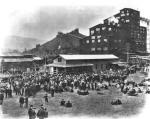![header=[Marker Text] body=[Formed August 13, 1878 from Luzerne County, it was Pennsylvania's 67th and last county created. The name is an Indian word meaning "stream that forks." Scranton, the county seat, was made a city, 1866. It became the anthracite coal mining capital of the world. ] sign](http://explorepahistory.com/kora/files/1/10/1-A-C6-139-ExplorePAHistory-a0a4u4-a_450.gif)
Mouse over for marker text
Name:
Lackawanna County
Region:
Poconos / Endless Mountains
County:
Lackawanna
Marker Location:
Courthouse Square, Spruce Street, Scranton
Dedication Date:
May 25, 1982
Behind the Marker
Anthracite in Lackawanna County comes from the Northern Coal Field, a crescent-shaped geological designation split between Lackawanna and Luzerne Counties, in an area more popularly known as the Wyoming Valley. Though it was the last developed of the four coal fields, it was considered the prize because it contains some of the richest anthracite deposits in the world. The elite of Wilkes-Barre in Luzerne County, an industrial center established at the beginning of anthracite mining and transportation era, fought against the establishment of Lackawanna County and attempted to contain the rise of Scranton, its rival city.
Even though Scranton became known as the "anthracite coal mining capital of the world," it also evolved into a major manufacturing center, with entrepreneurs and investors enticed to the area by the Scrantons, as well as a railroad junction that was vital to its success. In the 1840s the Scranton family first tried manufacturing pig iron, and then nails, but both ventures were unsuccessful, in large part because the area lacked affordable transportation routes to markets.
In an even riskier move, they borrowed money from New York investors after securing the rail contract for a new line of the New York and Erie Railroad. They finally achieved success with this project and by 1853 had incorporated their Lackawanna Iron and Coal Company. In the same year, the family also built two railroads from Scranton, running north and east. These lines would later become the Delaware, Lackawanna and Western Railroad.
Coal and rail operations employed thousands in Dickson City, Olyphant, Dunmore, Carbondale, and other Lackawanna County towns. Less well-known is Throop, just north of Scranton. There, in 1911, a fire that originated in the engine room suffocated seventy-three miners at the Pancoast mine, operated by the Scranton Coal Company. In response to the Anthracite Mine Disaster, the Pennsylvania legislature revised the state's mining laws to require all underground buildings to be constructed of incombustible materials.
Anthracite Mine Disaster, the Pennsylvania legislature revised the state's mining laws to require all underground buildings to be constructed of incombustible materials.
Even though Scranton became known as the "anthracite coal mining capital of the world," it also evolved into a major manufacturing center, with entrepreneurs and investors enticed to the area by the Scrantons, as well as a railroad junction that was vital to its success. In the 1840s the Scranton family first tried manufacturing pig iron, and then nails, but both ventures were unsuccessful, in large part because the area lacked affordable transportation routes to markets.
In an even riskier move, they borrowed money from New York investors after securing the rail contract for a new line of the New York and Erie Railroad. They finally achieved success with this project and by 1853 had incorporated their Lackawanna Iron and Coal Company. In the same year, the family also built two railroads from Scranton, running north and east. These lines would later become the Delaware, Lackawanna and Western Railroad.
Coal and rail operations employed thousands in Dickson City, Olyphant, Dunmore, Carbondale, and other Lackawanna County towns. Less well-known is Throop, just north of Scranton. There, in 1911, a fire that originated in the engine room suffocated seventy-three miners at the Pancoast mine, operated by the Scranton Coal Company. In response to the
Beyond the Marker






